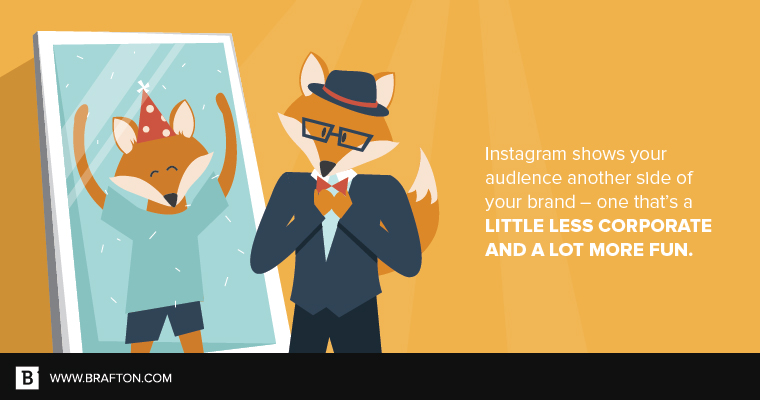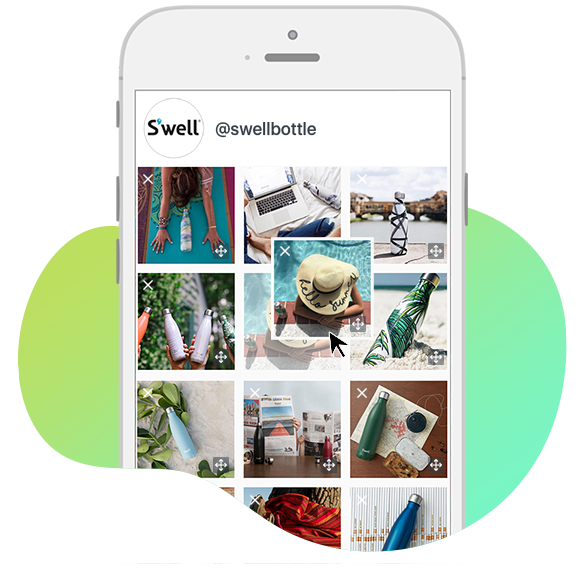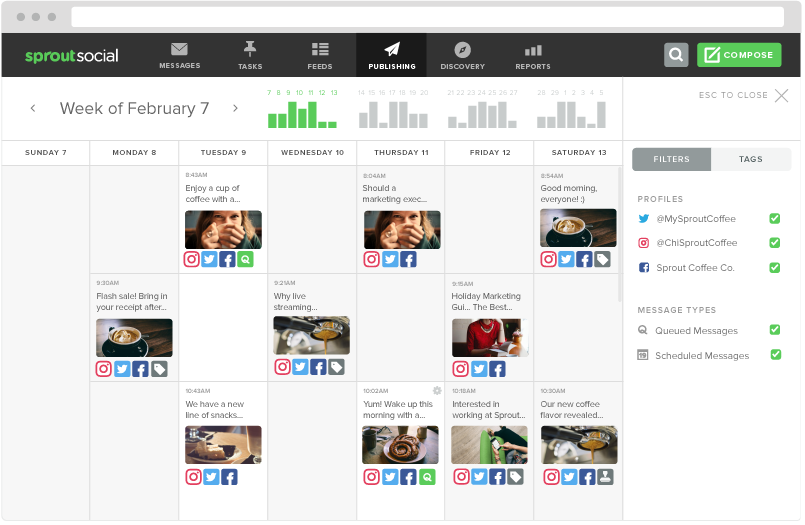I can honestly say that Instagram is my favorite social media app. It keeps me connected to the people, products and brands I care about most.
(Beyoncé is barely active on Twitter, but have you seen her latest Instagram posts? #Flawless #Slay.)
With 500 million active daily users, it’s safe to say there are a bunch of people out there who feel the same way.
That’s why Instagram is an important part of any company’s content marketing strategy. Its ability to boost audience engagement is unique and unparalleled. Instagram shows your audience another side of your brand – one that’s a little less corporate and a lot more fun.
Yet for all the platform’s potential, it can be downright mystifying if you don’t know what you’re doing. That’s okay; we’re here to help.
Here are 5 concepts you need to know about marketing on Instagram.

1. Basic tips and tricks to boost your profile
Everyone knows a tweet is 140 characters – okay, fine, now it’s 280 – but how long can an Instagram caption be? How many seconds of video can you upload? Before we dive into the nitty gritty of marketing strategies, let’s get the basics out of the way first:
Profile
Your Instagram bio is limited to 150 characters. It’s also the only area where you can place a URL – you can’t add links to images or captions. Your bio should link to your homepage at the bare minimum, but don’t be afraid to direct your audience to other areas of your website, such as your blog, contact page, promotion or even a press release.
Content
Instagram is a visual platform, so you’re limited in the types of content you can share. That said, each image or video includes a caption. These are restricted to 2,200 characters.
Keep in mind that viewers can see only the first 3 to 4 lines initially. The rest is hidden behind a cut. Put your most important or interesting information at the beginning, but don’t shy away from longer captions.
Also, no caption is complete without a hashtag! These help viewers find your post when using Instagram’s search feature. To prevent your content from looking like spam, post your hashtags after your caption. If you want to hide the hashtags completely behind the cut, open up a text editor like Notes or Evernote and type in your caption. Put a dot or period on the next line, then hit return. Repeat that last step five times. Then, copy and paste the entire caption back into Instagram.
With captions and hashtags out of the way, let’s quickly run through the types of content you can post:
- Photos: Instagram is known for popularizing square mobile photography. It’s possible to add landscape images, but note that they’ll be cropped to a square when your profile is displayed as a grid.
- Videos: Instagram videos must be at least 3 seconds long but max out at 1 minute.
- Instagram Stories: These are short, temporary videos that aren’t archived in your profile. Instagram Stories are only available for 24 hours, so they’re great for increasing engagement by generating a sense of urgency.
- Instagram Live: This is Instagram’s answer to the popular livestreaming phenomenon, letting you capture and share real-time video with your audience. Viewers can respond instantly, but there’s no long-term replay feature; once you stop recording, the feed is briefly sent to your Stories before being dropped for good.
Each type of content has its individual strengths. When combined as part of a well-thought-out strategy, they boost your business’s engagement and brand familiarity.
2. Methods for optimizing your Instagram marketing strategy
Strategy is just as important on Instagram as it is on any other platform. Without one, I guarantee your marketing will look haphazard. Because this medium is visual, viewers will notice branding discrepancies more immediately than they would in a blog or Facebook post.
First and foremost, your strategy needs to take Instagram’s strengths into account. Like I said earlier, this site is great for increasing brand recognition and getting an immediate reaction from your audience. Your content needs to be compelling – perhaps even emotional – and inspire your viewers to get engaged.
It also needs to be consistent, as Instagram feeds don’t appear in chronological order. Instead, they’re displayed according to a very particular algorithm. While Instagram hasn’t shared the specifics of this formula, we do know that timeliness is a factor. You don’t want to spam your followers with several updates in rapid succession, but posting infrequently compromises your reach. Keep this detail in mind when creating your social media content calendar, and note that while Instagram doesn’t let you schedule posts internally, there are plenty of third-party apps that get the job done. A few of our favorites are:

Finally, determine what type of content to focus on. What performs better for your audience: photos, videos, Instagram Live? Data from Instagram’s internal analytics tool, which we’ll cover in the next section, will direct you to the answer. Make this the dominant part of your marketing strategy, but remember to include other forms of content on occasion.
As you’re creating your strategy, consider every photo and video as one piece of a larger whole. This idea is evident in the grid layout – every image comes together to form your profile. Your posts have to look good on their own, but they must also work well when displayed next to each other. Think of your Instagram content like art in a museum – there’s a reason so many influencers refer to their own feeds as “curated.”
3. Where to obtain analytics
Content marketing is all about learning from data.
Instagram knows this and provides businesses valuable information to help them reach their marketing goals. Once you hit 100 followers or more, you’ll be able to access the platform’s native analytics tool, Instagram Insights. It gives you a variety of metrics, including reach, impressions, profile views and website clicks. Some of the specific information you can see includes:
- How many unique visitors viewed your profile.
- How many times a video was shared between users.
- The number of users that saved your posts.
- The number of times your ads were displayed.
Additionally, Instagram provides demographic information on your users, including:
- Age.
- Gender.
- Location.
This information helps you create content that better targets your audience.
That said, there are a ton of third-party tools that provide deeper insights and greater functionality. Here are some of our recommendations:

4. Other apps to boost your Instagram content
Instagram’s editing features are pretty robust, but third-party applications let you do so much more. Both the App Store and Google Play have dozens of free and paid tools to enhance your photos and videos. If you don’t know where to start, here are some that are guaranteed to help you create eye-catching content:
- Snapseed is a photo-editing software for iOS and Android with more capabilities than Instagram’s native tools.
- Boomerang takes a burst of photos and loops them into a seconds-long gif that plays forward and backward.
- Layout combines multiple images into one picture. It’s not as heavily relied upon now that Instagram lets you add multiple images to one post, but it still has a lot of interesting effects to experiment with.
- Splice lets you edit videos on your mobile device. Trim and cut content or add transitions, voiceovers and more.
5. How to use Instagram for B2B
The phrase “Instagram marketing” often brings to mind clothes, accessories, homewares – basically, anything in the B2C environment. But that’s not all the platform is good for; B2B marketers can find homes here, too.
Arguably, Instagram’s most beneficial asset is its ability to humanize a brand. The platform is a great tool for taking your audience behind the scenes, showing them what makes your business tick and allowing people to get to know you.
With that in mind, the best way to use Instagram to your advantage is to show off your company culture. Audiences like seeing that human aspect, so don’t be afraid to show the people behind the product. You might – oh, I don’t know – share a picture of your teams celebrating your best success stories for the quarter, or show staff participating in an outdoor activity.
Stuck for ideas? Don’t worry, we’ve got you covered:
- Post pictures of a productive brainstorming session. Include group shots of your staff, coffee-stained notepads or close ups of notes and doodles.
- Post a portrait of an individual employee, and caption with their thoughts on a particular aspect of your industry – sort of like Humans of New York but specific to your organization. You can also try this idea as a video if those perform better for you.
- Share company or industry events via the Stories feature. These can be anything from the office holiday party to a panel at a trade show.
- Host a Q&A session on Instagram Live. Let your audience know the date and time in advance, compile a few questions and impart your wisdom. Viewers can comment in real time, increasing engagement and allowing you to answer questions instantly.
That’s a lot of information, but using Instagram as a content marketing tool is surprisingly easy. As long as you focus on the platform’s strengths and, as always, use data to guide your actions, you should have no trouble.
Now, if you’ll excuse me, I’m going to go see if Queen Bey’s posted any new selfies.





